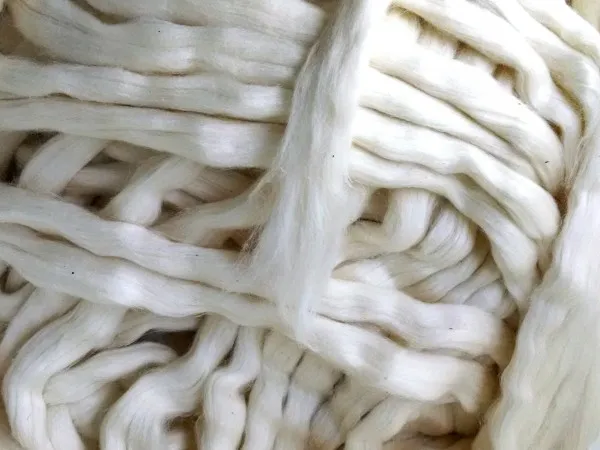In the textile industry, sliver is a loosely bundled fiber created during carding or combing, serving as an intermediate stage before yarn or fabric. Proper handling is crucial for maintaining fiber alignment and preventing defects in the final product.
This article explains why different sliver types need distinct handling systems to help textile manufacturers optimize processes, improve quality, and boost efficiency.
Understanding Sliver Types

Natural Fiber Sliver
Natural fiber sliver include materials such as cotton, wool, and silk. These fibers are harvested from plants or animals and are known for their unique properties. Cotton sliver, for instance, is soft and fluffy but can be prone to tangling and breakage. Wool slivers, on the other hand, are resilient and elastic but require careful handling to prevent felting. Silk sliver is delicate and smooth, necessitating gentle processing to maintain its luster.
Synthetic Fiber Sliver
Synthetic fibers, such as polyester, nylon, and acrylic, are man-made through chemical processes. Polyester sliver is strong and durable but can generate static electricity, complicating handling. Nylon sliver is elastic and resistant to wear but may be slippery, requiring specialized equipment to manage it effectively. Acrylic sliver is lightweight and soft, similar to wool, but demand careful control of temperature and humidity to prevent deformation.

Blended Fiber Sliver
Blended fiber sliver combines natural and synthetic fibers to leverage the benefits of both. Common blends include cotton-polyester, which offers the comfort of cotton and the durability of polyester. Handling blended sliver can be complex due to the varying characteristics of the component fibers. Effective handling systems must balance these differences to produce a consistent, high-quality end product.
Sliver Handling Systems
Manual Handling Systems
Manual handling systems rely on human labor to manage and transport sliver. This approach is often used in smaller, artisanal textile operations where production volumes are low. Manual systems allow for flexibility and careful attention to detail but can be labor-intensive and less consistent than automated methods.
Pros | Cons |
|
|
Semi-Automatic Handling Systems
Semi-automatic systems combine manual labor with mechanized equipment. These systems often involve machines for transporting and aligning sliver, with human operators overseeing and adjusting the process as needed. Semi-automatic systems are commonly used in medium-sized textile operations.
Pros | Cons |
|
|
Fully Automated Handling Systems
Fully automated handling systems use advanced machinery and software to manage slivers without the need for constant human intervention. These systems are ideal for large-scale textile production, offering high efficiency and consistency. Automated systems can be programmed to handle different sliver types, adjusting settings for optimal performance.
Pros | Cons |
|
|
Matching Sliver Types to Handling Systems
Natural Fiber Sliver Handling
For natural fiber slivers, manual or semi-automatic systems are often preferred due to the delicate nature of these fibers. Cotton sliver, for example, benefits from manual handling to minimize breakage. Wool slivers, which are more resilient, can be processed using semi-automatic systems that balance careful handling with efficiency. Silk sliver requires gentle, precise handling, making manual systems the best choice for maintaining its quality.
Synthetic Fiber Sliver Handling
Synthetic fibers like polyester and nylon benefit from fully automated systems. These systems can manage the static electricity generated by polyester and the slipperiness of nylon, ensuring smooth processing. Automated systems also maintain consistent environmental conditions, crucial for handling synthetic fibers.
Blended Fiber Sliver Handling
Handling blended fiber slivers requires systems that can accommodate the properties of both natural and synthetic components. Semi-automatic systems are often ideal, as they offer a balance of flexibility and efficiency. These systems can be adjusted to handle the differing requirements of each fiber type in the blend.
Key Factors in Selecting Sliver Handling Systems
Fiber Properties
The physical properties of fibers, such as strength, elasticity, and fineness, influence the choice of handling systems. For example, strong and durable fibers like polyester can be handled by fully automated systems, while delicate fibers like silk require manual handling.
Production Volume
The scale of production is a critical factor. Small-scale operations may prefer manual systems for their flexibility and lower cost, while large-scale manufacturers benefit from the efficiency of automated systems.
Cost Considerations
Initial investment and operational costs are important when selecting a sliver handling system. Manual systems have lower upfront costs but higher labor expenses, while automated systems require significant investment but offer long-term savings through efficiency gains.
Technological Integration
Compatibility with existing equipment and processes is essential. A handling system should integrate smoothly with other stages of textile production, such as spinning and weaving, to ensure a streamlined workflow.
Innovations in Sliver Handling
Recent Technological Advancements
Recent advancements in sliver handling include the integration of smart technology and the Internet of Things (IoT). Smart handling systems use sensors and data analytics to monitor and adjust processes in real time, improving efficiency and reducing waste. IoT integration allows for remote monitoring and control, enabling manufacturers to optimize their operations from anywhere.
Future Trends
Future trends in sliver handling technology include increased automation, further integration of smart technology, and the development of more versatile systems capable of handling a wider range of fiber types. These advancements will continue to enhance efficiency, consistency, and product quality in textile manufacturing.
Conclusion
Different sliver types need specific handling systems: natural fibers suit manual or semi-automatic systems, synthetic fibers need automation, and blended fibers require flexible semi-automatic solutions.
Choosing the right sliver handling system is vital for textile manufacturers. Understanding each fiber type’s needs and considering factors like production volume, cost, and technology helps improve operations, reduce waste, and produce high-quality textiles efficiently.

